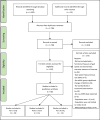A systematic review of mechanisms of gait speed change post-stroke. Part 1: spatiotemporal parameters and asymmetry ratios
- PMID: 28220715
- PMCID: PMC5875693
- DOI: 10.1080/10749357.2017.1285746
A systematic review of mechanisms of gait speed change post-stroke. Part 1: spatiotemporal parameters and asymmetry ratios
Abstract
Background: In walking rehabilitation trials, self-selected walking speed (SSWS) has emerged as the dominant outcome measure to assess walking ability. However, this measure cannot differentiate between recovery of impaired movement and compensation strategies. Spatiotemporal variables and asymmetry ratios are frequently used to quantify gait deviations and are hypothesized markers of recovery.
Objectives: The purpose of this review is to investigate spatiotemporal variables and asymmetry ratios as mechanistic recovery measures in physical therapy intervention studies post-stroke.
Methods: A systematic literature search was performed to identify physical therapy intervention studies with a statistically significant change in SSWS post intervention and concurrently collected spatiotemporal variables. Methodological quality was assessed using the Cochrane Collaboration's tool. Walking speed, spatiotemporal, and intervention data were extracted.
Results: 46 studies met the inclusion criteria, 41 of which reported raw spatiotemporal measures and 19 reported asymmetry ratio calculations. Study interventions included: aerobic training (n = 2), functional electrical stimulation (n = 5), hippotherapy (n = 2), motor dual task training (n = 2), multidimensional rehabilitation (n = 4), robotics (n = 4), sensory stimulation training (n = 8), strength/resistance training (n = 4), task specific locomotor rehabilitation (n = 9), and visually guided training (n = 6).
Conclusions: Spatiotemporal variables help describe gait deviations, but scale to speed, so consequently, may not be an independent factor in describing functional recovery and gains. Therefore, these variables are limited in explaining mechanistic changes involved in improving gait speed. Use of asymmetry measures provides additional information regarding the coordinative requirements for gait and can potentially indicate recovery. Additional laboratory-based mechanistic measures may be required to truly understand how walking speed improves.
Keywords: BWSTT: body weight supported treadmill training; SSWS: self-selected walking speed; Stroke; rehabilitation; spatio-temporal analysis; walking speed.
Figures
References
-
- Ada L, Dean CM, Vargas J, Ennis S. Mechanically assisted walking with body weight support results in more independent walking than assisted overground walking in non-ambulatory patients early after stroke: a systematic review. Journal of physiotherapy. 2010;56(3):153–61. - PubMed
-
- Polese JC, Ada L, Dean CM, Nascimento LR, Teixeira-Salmela LF. Treadmill training is effective for ambulatory adults with stroke: a systematic review. Journal of physiotherapy. 2013;59(2):73–80. - PubMed
-
- Buurke JH, Nene AV, Kwakkel G, Erren-Wolters V, Ijzerman MJ, Hermens HJ. Recovery of gait after stroke: what changes? Neurorehabilitation and neural repair. 2008;22(6):676–83. - PubMed
-
- Behrman AL, Bowden MG, Nair PM. Neuroplasticity after spinal cord injury and training: an emerging paradigm shift in rehabilitation and walking recovery. Physical therapy. 2006;86(10):1406–25. - PubMed
-
- Levin MF, Kleim JA, Wolf SL. What do motor “recovery” and “compensation” mean in patients following stroke? Neurorehabilitation and neural repair. 2009;23(4):313–9. - PubMed
Publication types
MeSH terms
Grants and funding
LinkOut - more resources
Full Text Sources
Other Literature Sources
Medical
Miscellaneous


